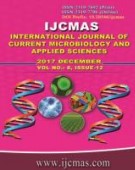


 National Academy of Agricultural Sciences (NAAS)
National Academy of Agricultural Sciences (NAAS)

|
PRINT ISSN : 2319-7692
Online ISSN : 2319-7706 Issues : 12 per year Publisher : Excellent Publishers Email : editorijcmas@gmail.com / submit@ijcmas.com Editor-in-chief: Dr.M.Prakash Index Copernicus ICV 2018: 95.39 NAAS RATING 2020: 5.38 |
Continued and widespread use of herbicides for controlling weeds and indirectly enhancing crop production often results in reduction in soil fertility and via food chain, human health. Realizing this threat, herbicide tolerant plant growth promoting rhizobacterial strains were isolated and identified. Of the total 40 bacterial strains, Bradyrhizobium sp. strain R5 and Pseudomonas sp. strain PS6 tolerated 3200 and 800 μg ml−1ofglyphosate and Quizalofop P ethyl, respectively. Bradyrhizobium sp. strain R5 and Pseudomonas sp. strain PS6 produced indoleacetic acid, exopolysaccharides, siderophores, ammonia and solubilized inorganic P even in the presence of herbicides. Scanning electron microscopic and CLSM images revealed a clear toxicity of herbicides to bacterial cells. The toxicity of herbicides to greengram plants increased with increasing rates of glyphosate and quizalofop. The herbicide tolerant Bradyrhizobium strain R5 and Pseudomonas sp. strain PS6 when used with herbicide, considerably reduced toxicity to greengram plants. For example, Bradyrhizobium strain R5 significantly increased the nodule number, nodule dry mass, root and shoot length, root and shoot weight and total chlorophyll content by 10, 33 3, 16, 68, 23 and 6% respectively, whereas, inoculation of Pseudomonas sp. strain PS6 enhanced the measured parameters by 2, 7, 3, 12, 25, 22 and 20%, respectively, as compared to the plants grown solely with 1444 μg kg-1 of glyphosate. Among the two bacterial strains, Bradyrhizobium R5 showed better results under identical herbicide stress as compared to the Pseudomonas PS6. In general, the present findings suggest that both Bradyrhizobium sp. strain R5 and Pseudomonas sp. strain PS6 could be exploited as an efficient microbial inoculant to increase the productivity of greengram while reducing the toxicity of glyphosate and quizalofop.
 |
 |
 |
 |
 |